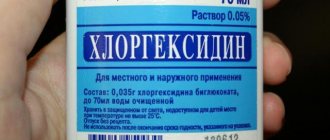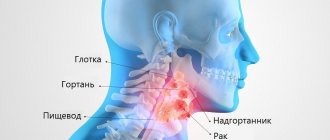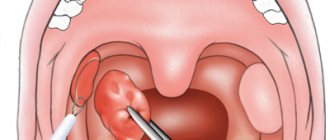A little anatomy
The pharynx is part of the respiratory tract and digestive tract. It contains a whole complex of lymphoid formations called the Pirogov-Waldeyer pharyngeal ring. The ring includes the palatine, pharyngeal, lingual, tubal tonsils, as well as lymphoid granules and ridges that are located on the lateral walls of the pharynx.
The tissues of the pharynx are penetrated by a huge number of blood vessels. Their superficial location provides warming or cooling of the air inhaled through the mouth and nose. In contact with the mucous membrane, the air is cleared of dust, chemical impurities and various microorganisms. Dust particles, substances and microbes settled on the mucous membrane irritate it, which sometimes causes inflammation and redness of the throat1.
Up to contents
Treatment
You need to start treating a sore throat in an adult as early as possible. Treatment is selected individually, depending on the diagnosis and examination data. Before prescribing medications, a throat swab must be taken to determine the pathogen and its sensitivity to certain drugs.
If the disease is caused by bacteria, then the treatment protocol must include antibacterial drugs. Preference is usually given to broad-spectrum antibiotics. Local antiseptics can also be used.
For a loose throat, all kinds of gargles have a good effect. For rinsing, you can use solutions prepared at home or pharmaceutical preparations. Your doctor may recommend the following formulations:
- Chamomile decoction.
- Yarrow decoction.
- A decoction of a herbal collection that includes chamomile, calendula, eucalyptus and elecampane.
- An aqueous solution of calendula tincture. To do this, take a dessert spoon of alcohol tincture into a glass of warm water. This composition disinfects a loose throat well.
- Furacilin solution. To prepare, take two crushed tablets and dissolve them in a glass of hot water.
- Miramistin. To rinse, you can use a clear solution or treat your tonsils with a spray.
Pharmacy antiseptic solutions should not be used if the soreness of the throat is not accompanied by pain and redness. In this case, it is better to use a sea salt solution for treatment. It is prepared from a glass of water and a full teaspoon of salt. To prepare the solution, you can use not only sea salt, but also table salt. In this case, a couple of drops of alcohol tincture of iodine should be added to the composition. In the acute period, it is recommended to gargle every hour.
Experts recommend gradually reducing the temperature of gargling solutions. This leads to hardening and increased local immunity.
Causes of red throat
Redness of the throat may be due to factors unrelated to infection2:
- Mechanical injuries to the mucous membrane of the pharynx due to solid food and bones.
- Eating hot food that can cause thermal burn2.
- Irritation or burn of the pharynx with chemicals (acids, alkalis, alcohol-containing liquids)2.
- Eating excessively spicy foods (hot pepper, ginger, horseradish, mustard can cause irritation of the mucous membranes).
- Inhalation of tobacco smoke, dust or air contaminated with mechanical and chemical impurities.
Eating food containing red food dyes. In this case, the throat is red, but does not hurt.
Up to contents
What to pay attention to
To quickly get rid of a sore throat or pharyngitis and prevent the development of complications, you should follow these recommendations:
- In the acute period of the disease, bed rest is required.
- Eat well. The diet should contain natural foods rich in vitamins and nutrients.
- Drink a lot. The patient must be constantly given fortified drinks. This can be a rosehip decoction, decoctions of medicinal herbs, juices, compotes and fruit drinks.
- The patient should be restricted from communicating with people suffering from respiratory diseases.
- During the recovery period after illness, you need to walk a lot in the fresh air, away from dusty roads and factories. You should always dress appropriately for the weather.
- Any contact with allergens should be limited.
Do not forget about maintaining optimal temperature and humidity in your home. For a person with a loose throat, drying out of the mucous membrane is very dangerous.
Timely treatment will help prevent the disease from becoming chronic . If you have a loose throat for a long time, your doctor may recommend having your tonsils removed.
What diseases cause the throat to turn red?
Pharyngitis, or inflammation of the pharynx, is one of the most common causes of redness of the throat. The disease can occur acutely or chronically1.
Acute pharyngitis
In 70% of cases, it accompanies ARVI and is more often associated with rhinovirus infection, which is especially common in the autumn2. In addition, influenza viruses, parainfluenza, adenoviruses, and respiratory syncytial virus can cause inflammation.
With viral pharyngitis, the throat looks red, “dry”, and the main complaints are soreness, dryness and pain in the throat, causing an obsessive superficial cough. The general condition depends on the nature of ARVI.
Viral inflammation often paves the way for bacterial infection2 caused by staphylococci, streptococci, neisseria, chlamydia, mycoplasma1. Bacterial pharyngitis is usually purulent and is characterized by an increase in temperature to 38°C or higher, and the appearance of purulent sputum.
Attention! Pharyngitis can be one of the first manifestations of “childhood” infections: measles, scarlet fever, rubella2. In adults, these infections are often severe and lead to complications2. Only a doctor can make the correct diagnosis.
In addition to viruses and bacteria, the cause of acute pharyngitis can be:
- allergic reactions1,2;
- diseases of the digestive system, in which the acidic contents of the stomach are thrown into the esophagus and pharynx (this includes cardial insufficiency and reflux esophagitis)1,2;
- tumor formations of the pharynx, including malignant1;
- specific infectious and inflammatory diseases (syphilis, tuberculosis, candidiasis)1.
Up to contents
Chronic pharyngitis
Its development can be caused by 3:
| Frequent colds | recurrent (repeating) acute respiratory diseases, which affect the upper respiratory tract and impair nasal breathing: rhinitis, sinusitis, adenoiditis |
| Gastropharyngeal reflux | periodic reflux of stomach contents into the esophagus and pharynx |
| General diseases | diabetes mellitus, renal and liver failure, immunodeficiency states3 |
Chronic pharyngitis can occur in three forms: catarrhal, hypertrophic and atrophic3.
With catarrhal inflammation, the throat is red, swollen, and there is discomfort: pain, soreness, tickling, sensation of a foreign body in the throat3.
Hypertrophic pharyngitis leads to thickening of the mucous membrane and proliferation of lymphoid formations. The walls of the pharynx become red, moist, and covered with a network of dilated blood vessels. Discomfort in the throat may be accompanied by a feeling of a foreign body in the throat and stuffy ears3.
Atrophic processes associated with tissue malnutrition are accompanied by thinning of the pharyngeal mucosa. Upon examination, it looks “dry”, “tight”, “granules” of lymphoid tissue rise above the general surface. The main complaints are dry throat and a dry, superficial cough that occurs at the slightest irritation of the respiratory tract3.
By the way, the development of atrophic pharyngitis is sometimes associated with frequent and prolonged instillation of vasoconstrictor drugs into the nose. Flowing into the nasopharynx, these drugs cause spasm of blood vessels, impair the nutrition of the mucous membrane and provoke its atrophy3.
Chronic pharyngitis is not common in children. Its development is facilitated by postnasal drip - the flow of mucus into the throat from the nasal cavity and paranasal sinuses. In this case, wheezing, reminiscent of bronchial asthma, may appear. Special examination helps to exclude the disease2.
A chronic inflammatory process in the pharynx weakens its protective functions and predisposes to frequent acute respiratory viral infections. Exacerbation of pharyngitis is facilitated by hypothermia of the throat in winter, inhalation of hot steam and air during inhalation, in a bath or sauna, consumption of hard, hot and spicy, excessively sweet and salty foods, alcoholic beverages, etc.3.
Up to contents
Causes of sore throat
The occurrence of the symptom is usually associated with various inflammatory and non-inflammatory processes both in the respiratory tract and in the organs that are located next to the pharynx and larynx. Less commonly, irritation of the pharyngeal mucosa is of physiological origin and is caused by eating spicy or too hot food, inhaling frosty air while walking or running quickly. Itching, caused by dry mucous membranes, is observed when the overall humidity in the room decreases.
Inflammation of the oropharynx
Pathological processes involving the mucous membrane of the oropharynx are the most common cause of soreness. The development of the symptom is due to irritation of nerve endings due to swelling and infiltration of the mucous membrane, release of inflammatory mediators, vasodilation and desquamation of the affected epithelium. Perspiration occurs against the background of diseases such as:
- Respiratory viral infections
. Most ARVI pathogens have a high affinity for epithelial cells of the oropharynx and larynx. After the introduction of influenza viruses, parainfluenza, rhinoviruses, and other viral particles, a local inflammatory reaction is formed, accompanied by soreness and then pain in the throat. In some diseases, discomfort in the throat precedes damage to other systems: the digestive tract (rotavirus infection), lungs (coronaviruses), lymphatic tissue (infectious mononucleosis), parenchymal organs and skin (rubella). - Bacterial inflammation
. A sore throat caused by persistent bacteria is often observed with streptococcal infections. Significant discomfort is observed with sore throat, acute pharyngitis and chronic tonsillitis. Severe itching caused by mucus draining from the nose and spasmodic coughing is characteristic of whooping cough. Severe nasopharyngitis with severe intoxication is observed with meningococcal infection. Moderate tickling in combination with other catarrhal symptoms manifests itself as a flu-like form of psittacosis. - Catarrhal reaction in other infections
. Discomfortable tickling sensations occur at the initial stage of some acute and chronic infectious diseases that cause systemic damage to the body. Flu-like sore throat is possible in patients with developing viral hepatitis A, pseudotuberculosis and secondary syphilis. A feature of the symptom in such pathological conditions is its frequent combination with general intoxication, arthralgia, myalgia, skin rashes and other signs of multiple organ disorders.
Severe erosive and ulcerative destruction of the epithelium with intense soreness and soreness in the throat is observed in infectious diseases of the oropharynx and nasopharynx against the background of decreased immunity (pharyngomycosis, lesions of the ENT organs in HIV-infected people). The symptom is felt more pronounced against the background of ARVI during pregnancy, which is associated with physiological suppression of the body’s defenses and increased emotionality of pregnant women.
Non-inflammatory pathology of the oropharynx
Irritation with the appearance of characteristic scratchy sensations is observed when the mucous membrane is exposed to non-infectious factors - mechanical trauma, pressure from space-occupying formations. Sometimes the symptom is provoked by food intake (damage from solid foods, fish bones), stress, conflict, or anxiety. In non-inflammatory diseases, hyperthermia and other signs of general intoxication are often absent, but copious pathological discharge (mucous, bloody discharge) is possible.
Perspiration is observed when tissue is damaged by foreign bodies, the presence of a tonsil cyst, or benign tumors of the pharynx. In a Le Fort 1 fracture of the upper jaw, a tickling sensation is associated with a downward displacement of the uvula of the soft palate and, as a rule, is combined with nausea and obstruction of the upper respiratory tract. In rare cases, the symptom has a functional origin and develops against the background of a hyperesthetic variant of pharyngeal neurosis, accompanied by a feeling of dry mucous membranes and a lump in the throat.
Diseases of the larynx
The occurrence of uncomfortable tickling sensations is associated with the anatomical proximity of the pharynx and the upper respiratory tract, the possibility of ascending or descending spread of inflammatory and destructive processes, and vascular reactions. In this case, the tickling is combined with characteristic voice disorders - dysphonia or aphonia. The causes of the symptom are usually:
- Inflammatory diseases
. Specific manifestations of soreness for acute or chronic laryngitis include a feeling of dry mucous membranes, burning, tickling, and scratching. Discomfort is first localized in the upper part of the neck, then it can spread to the back wall of the pharynx. In chronic hyperplastic laryngitis, in addition to soreness and hoarseness, a foreign body sensation is often noted. For laryngotracheitis, a combination of a tickling sensation and a cough is typical. General intoxication is often mild or moderate. - Neurotic disorders
. A persistent subjective sensation of tickling sensation in the laryngopharyngeal region is a characteristic sign of voice formation disorders with functional paresis of the larynx. The feeling of discomfort is aggravated by pain and a transient change in phonation. There are no visible signs of inflammatory or other pathological processes, the voice remains quite sonorous during laughter, coughing and crying, other neurotic stigmas are detected: complaints of headache, emotional lability, fatigue, insomnia.
The occurrence of soreness at the level of the larynx is also possible with the development of benign tumors, cancer of the hypopharynx and larynx. Such uncomfortable sensations are particularly persistent and are combined with progressive voice impairment and breathing difficulties. When the tumor is localized in the lower part of the pharynx, abundant salivation is observed.
Thyroid diseases
The development of tickling sensations when thyroid tissue is damaged is facilitated by the anatomical location of the organ in the upper part of the trachea, its innervation by the recurrent laryngeal nerve, the fibers of which provide sensitivity and motility of the larynx. A sore throat in the middle and lower part of the throat is accompanied by thyroid nodules and cysts, papillary cancer, and other neoplasms growing in the direction of the respiratory tract. In the later stages of the volumetric process, breathing difficulties and visible deformation of the neck are also detected. Possible signs of hyperthyroidism: emotional lability, irritability, exophthalmos, tachycardia.
Allergy
Various types of discomfort in the nasopharynx and oropharynx are typical for acute atopic reactions and chronic allergic diseases. In the first case, tickling occurs suddenly, is combined with nasal congestion, lacrimation, sneezing and skin itching, most often manifested by allergies to dust, pets, or pollen. As a concomitant symptom, tickling sensations in the larynx and pharynx are noted during paroxysmal cough with difficulty breathing and expiratory shortness of breath in allergic bronchitis. The cause of the development of soreness in allergies is usually irritation of the mucous membrane due to the release of histamine and other inflammatory mediators by mast cells under conditions of sensitization to a particular allergen.
Bronchopulmonary pathology
The causes of discomfort in the pharynx and larynx during diseases of the bronchi and lungs are usually irritation of the mucous membrane when it comes into contact with expectorated sputum, other pathological discharge and a reaction to a strong cough. With tracheobronchitis and acute bronchitis, tickling is often combined with rhinorrhea or dry nasopharynx, hoarseness, and pain when swallowing. Symptoms of acute respiratory infections with a tickling sensation sometimes appear in the initial stages of certain types of pneumonia - atypical mycoplasma and caseous pneumonia.
With aspergillus tracheobronchitis and interstitial pneumonia, the main clinical symptoms are preceded by persistent discomfort in the pharynx, larynx with hyperthermia and a persistent feeling of bitterness in the mouth. Soreness and changes in voice accompanied by a persistent cough, pain when inhaling, and expiratory shortness of breath are observed during secondary infection in patients with osteochondroplastic tracheobronchopathy. Most pathological processes accompanied by hemoptysis also occur with a tickling sensation.
Esophageal damage
The development of symptoms in patients suffering from esophageal pathology is often caused by the reflux of gastric contents due to violations of the closure function of the cardia. When aggressive secretions and digested food enter the esophageal mucosa, irritation spreads to the upper sections. In addition, when belching occurs, the acidic contents of the stomach directly affect the epithelium of the pharynx, causing a local response.
Perspiration is observed with gastroesophageal reflux disease, especially against the background of GERD during pregnancy, when there is a higher reflux of liquid gastric chyme. Such tickling sensations with a burning sensation in the hypopharynx, dysphagia, coughing up large amounts of mucus and dysphonia are caused by laryngopharyngeal reflux. Scratching of the throat, dry cough, excessive salivation, and a “lump in the throat” are characteristic of diverticulosis of the esophagus with the formation of pharyngoesophageal pouch-like protrusions (Zenker’s diverticulum).
Occupational pathology
Irritation of the laryngopharyngeal mucosa associated with the performance of work duties is observed with inhalation of toxic substances and high vocal load. Occupational diseases, the clinical picture of which may include a sore throat symptom, can occur both acutely and chronically. Patients often experience voice changes and signs of damage to the bronchi and lungs. The causes of tickling sensations in the larynx and oropharynx can be:
- Acute poisoning
. Acute berylliosis, foundry fever and toxic pulmonary edema begin with a feeling of dry mucous membranes, soreness in the larynx and pharynx, an unusual taste in the mouth, and sometimes watery eyes. Subsequently, the clinical picture quickly worsens with hyperthermia, myalgia, paroxysmal cough, chest pain, and worsening general condition. - Chronic intoxication
. Changes in the mucous membrane of the laryngopharynx, manifested by soreness, are possible with pneumoconiosis and respiratory allergies. In patients suffering from occupational bronchial asthma and byssinosis, the symptom is often combined with difficulty inhaling and exhaling, coughing, shortness of breath, and then respiratory failure. - Damage to the vocal folds
. In specialists whose activities involve overload of the vocal apparatus, soreness is caused by local hyperplasia of the connective tissue. When nodules of the vocal cords appear, in addition to laryngopharyngeal discomfort and burning, the voice becomes hoarse, fatigue is noted, and an unproductive cough occurs.
Why does the temperature rise
Fever accompanies most infectious diseases, including acute tonsillitis2,3. The processes that cause an increase in body temperature are quite well studied. They are triggered by special substances pyrogens, which can enter the body from the outside (exogenous pyrogens) or be synthesized inside it (endogenous pyrogens).
Endogenous pyrogens are substances that enter the bloodstream during the destruction of immune cells and cells of the inflamed mucous membrane of the throat2,3.
Exogenous pyrogens in the case of tonsillitis can be various microorganisms: viruses, bacteria, fungi3. In children aged 3 months to 3 years, tonsillitis most often develops with mixed herpesvirus infections3. When a child reaches the age of 3-7 years, viruses give way to bacteria, and in 30% of cases the disease is caused by group A3 beta-hemolytic streptococcus. In addition, the tonsils are often affected by streptococci of other groups, staphylococci, etc.1 In adults, acute tonsillitis is often viral and accompanies ARVI1.
Exogenous and endogenous pyrogens affect the thermoregulation center located in the brain2,3. As a result, he begins to perceive normal body temperature as lower and increases the level of heat production, which leads to an increase in body temperature2,3.
Up to contents











